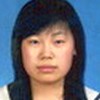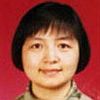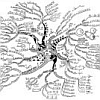| |
  
Mihaela Baroni,
Charles Semple and
Mike Steel. A framework for representing reticulate evolution. In ACOM, Vol. 8:398-401, 2004.
Keywords: explicit network, from clusters, hybridization, minimum number, phylogenetic network, phylogeny, reconstruction, regular network, SPR distance.
Note: http://www.math.canterbury.ac.nz/~c.semple/papers/BSS04.pdf.
Toggle abstract
"Acyclic directed graphs (ADGs) are increasingly being viewed as more appropriate for representing certain evolutionary relationships, particularly in biology, than rooted trees. In this paper, we develop a framework for the analysis of these graphs which we call hybrid phylogenies. We are particularly interested in the problem whereby one is given a set of phylogenetic trees and wishes to determine a hybrid phylogeny that 'embeds' each of these trees and which requires the smallest number of hybridisation events. We show that this quantity can be greatly reduced if additional species are involved, and investigate other combinatorial aspects of this and related questions."
|
|
| |
 
Philippe Gambette and
Katharina Huber. On Encodings of Phylogenetic Networks of Bounded Level. In JOMB, Vol. 65(1):157-180, 2012.
Keywords: characterization, explicit network, from clusters, from rooted trees, from triplets, galled tree, identifiability, level k phylogenetic network, phylogenetic network, uniqueness, weak hierarchy.
Note: http://hal.archives-ouvertes.fr/hal-00609130/en/.
Toggle abstract
"Phylogenetic networks have now joined phylogenetic trees in the center of phylogenetics research. Like phylogenetic trees, such networks canonically induce collections of phylogenetic trees, clusters, and triplets, respectively. Thus it is not surprising that many network approaches aim to reconstruct a phylogenetic network from such collections. Related to the well-studied perfect phylogeny problem, the following question is of fundamental importance in this context: When does one of the above collections encode (i. e. uniquely describe) the network that induces it? For the large class of level-1 (phylogenetic) networks we characterize those level-1 networks for which an encoding in terms of one (or equivalently all) of the above collections exists. In addition, we show that three known distance measures for comparing phylogenetic networks are in fact metrics on the resulting subclass and give the diameter for two of them. Finally, we investigate the related concept of indistinguishability and also show that many properties enjoyed by level-1 networks are not satisfied by networks of higher level. © 2011 Springer-Verlag."
|
|
| |
 
Leo van Iersel and
Steven Kelk. When two trees go to war. In JTB, Vol. 269(1):245-255, 2011.
Keywords: APX hard, explicit network, from clusters, from rooted trees, from sequences, from triplets, level k phylogenetic network, minimum number, NP complete, phylogenetic network, phylogeny, polynomial, reconstruction.
Note: http://arxiv.org/abs/1004.5332.
Toggle abstract
"Rooted phylogenetic networks are used to model non-treelike evolutionary histories. Such networks are often constructed by combining trees, clusters, triplets or characters into a single network that in some well-defined sense simultaneously represents them all. We review these four models and investigate how they are related. Motivated by the parsimony principle, one often aims to construct a network that contains as few reticulations (non-treelike evolutionary events) as possible. In general, the model chosen influences the minimum number of reticulation events required. However, when one obtains the input data from two binary (i.e. fully resolved) trees, we show that the minimum number of reticulations is independent of the model. The number of reticulations necessary to represent the trees, triplets, clusters (in the softwired sense) and characters (with unrestricted multiple crossover recombination) are all equal. Furthermore, we show that these results also hold when not the number of reticulations but the level of the constructed network is minimised. We use these unification results to settle several computational complexity questions that have been open in the field for some time. We also give explicit examples to show that already for data obtained from three binary trees the models begin to diverge. © 2010 Elsevier Ltd."
|
|
| |
 
Mihaela Baroni and
Mike Steel. Accumulation Phylogenies. In ACOM, Vol. 10(1):19-30, 2006.
Keywords: abstract network, from clusters, from distances, phylogenetic network, phylogeny, polynomial, reconstruction, regular network.
Note: http://citeseerx.ist.psu.edu/viewdoc/summary?doi=10.1.1.137.1960.
Toggle abstract
"We investigate the computational complexity of a new combinatorial problem of inferring a smallest possible multi-labeled phylogenetic tree (MUL tree) which is consistent with each of the rooted triplets in a given set. We prove that even the restricted case of determining if there exists a MUL tree consistent with the input and having just one leaf duplication is NP-hard. Furthermore, we show that the general minimization problem is NP-hard to approximate within a ratio of n 1-ε for any constant 0<ε≤1, where n denotes the number of distinct leaf labels in the input set, although a simple polynomial-time approximation algorithm achieves the approximation ratio n. We also provide an exact algorithm for the problem running in O *(7 n ) time and O *(3 n ) space. © 2009 Springer-Verlag Berlin Heidelberg."
|
|
| |
  
Steven Kelk,
Celine Scornavacca and
Leo van Iersel. On the elusiveness of clusters. In TCBB, Vol. 9(2):517-534, 2012.
Keywords: explicit network, from clusters, from rooted trees, from triplets, level k phylogenetic network, phylogenetic network, phylogeny, Program Clustistic, reconstruction, software.
Note: http://arxiv.org/abs/1103.1834.
|
|
| |
 
Steven Kelk and
Celine Scornavacca. Constructing minimal phylogenetic networks from softwired clusters is fixed parameter tractable. In ALG, Vol. 68(4):886-915, 2014.
Keywords: explicit network, FPT, from clusters, level k phylogenetic network, phylogenetic network, phylogeny, reconstruction.
Note: http://arxiv.org/abs/1108.3653.
Toggle abstract
"Here we show that, given a set of clusters C on a set of taxa X, where |X|=n, it is possible to determine in time f(k)×poly(n) whether there exists a level-≤k network (i.e. a network where each biconnected component has reticulation number at most k) that represents all the clusters in C in the softwired sense, and if so to construct such a network. This extends a result from Kelk et al. (in IEEE/ACM Trans. Comput. Biol. Bioinform. 9:517-534, 2012) which showed that the problem is polynomial-time solvable for fixed k. By defining "k-reticulation generators" analogous to "level-k generators", we then extend this fixed parameter tractability result to the problem where k refers not to the level but to the reticulation number of the whole network. © 2012 Springer Science+Business Media New York."
|
|
| |
   
Juan Wang,
Maozu Guo,
Linlin Xing,
Kai Che,
Xiaoyan Liu and
Chunyu Wang. BIMLR: A Method for Constructing Rooted Phylogenetic Networks from Rooted Phylogenetic Trees. In Gene, Vol. 527(1):344-351, 2013.
Keywords: explicit network, from clusters, from rooted trees, phylogenetic network, phylogeny, Program BIMLR, Program Dendroscope, reconstruction, software.
Toggle abstract
"Rooted phylogenetic trees constructed from different datasets (e.g. from different genes) are often conflicting with one another, i.e. they cannot be integrated into a single phylogenetic tree. Phylogenetic networks have become an important tool in molecular evolution, and rooted phylogenetic networks are able to represent conflicting rooted phylogenetic trees. Hence, the development of appropriate methods to compute rooted phylogenetic networks from rooted phylogenetic trees has attracted considerable research interest of late. The CASS algorithm proposed by van Iersel et al. is able to construct much simpler networks than other available methods, but it is extremely slow, and the networks it constructs are dependent on the order of the input data. Here, we introduce an improved CASS algorithm, BIMLR. We show that BIMLR is faster than CASS and less dependent on the input data order. Moreover, BIMLR is able to construct much simpler networks than almost all other methods. BIMLR is available at http://nclab.hit.edu.cn/wangjuan/BIMLR/. © 2013 Elsevier B.V."
|
|
| |

Juan Wang. A new algorithm to construct phylogenetic networks from trees. In Genetics and Molecular Research, Vol. 13(1):1456-1464, 2014.
Keywords: explicit network, from clusters, heuristic, phylogenetic network, Program LNetwork, Program QuickCass, reconstruction.
Note: http://dx.doi.org/10.4238/2014.March.6.4.
Toggle abstract
"Developing appropriate methods for constructing phylogenetic networks from tree sets is an important problem, and much research is currently being undertaken in this area. BIMLR is an algorithm that constructs phylogenetic networks from tree sets. The algorithm can construct a much simpler network than other available methods. Here, we introduce an improved version of the BIMLR algorithm, QuickCass. QuickCass changes the selection strategy of the labels of leaves below the reticulate nodes, i.e., the nodes with an indegree of at least 2 in BIMLR. We show that QuickCass can construct simpler phylogenetic networks than BIMLR. Furthermore, we show that QuickCass is a polynomial-time algorithm when the output network that is constructed by QuickCass is binary. © FUNPEC-RP."
|
|
| |
   
Adrià Alcalà Mena,
Mercè Llabrés,
Francesc Rosselló and
Pau Rullan. Tree-Child Cluster Networks. In Fundamenta Informaticae, Vol. 134(1-2):1-15, 2014.
Keywords: explicit network, from clusters, phylogenetic network, phylogeny, Program PhyloNetwork, reconstruction, tree-child network.
|
|
| |
|
| |
|
| |
  
Andreas Gunawan,
Bhaskar DasGupta and
Louxin Zhang. A decomposition theorem and two algorithms for reticulation-visible networks. In Information and Computation, Vol. 252:161-175, 2017.
Keywords: cluster containment, explicit network, from clusters, from network, from rooted trees, phylogenetic network, phylogeny, polynomial, reticulation-visible network, tree containment.
Note: https://www.cs.uic.edu/~dasgupta/resume/publ/papers/Infor_Comput_IC4848_final.pdf.
|
|
| |

Juan Wang. A Survey of Methods for Constructing Rooted Phylogenetic Networks. In PLoS ONE, Vol. 11(11):e0165834, 2016.
Keywords: evaluation, explicit network, from clusters, phylogenetic network, phylogeny, Program BIMLR, Program Dendroscope, Program LNetwork, reconstruction, survey.
Note: http://dx.doi.org/10.1371/journal.pone.0165834.
|
|
| |
|
|
|
| |
 
Luay Nakhleh and
Li-San Wang. Phylogenetic Networks, Trees, and Clusters. In IWBRA05, Vol. 3515:919-926 of LNCS, springer, 2005.
Keywords: cluster containment, evaluation, from clusters, from network, from rooted trees, phylogenetic network, phylogeny, polynomial, tree containment, tree-child network.
Note: http://www.cs.rice.edu/~nakhleh/Papers/NakhlehWang.pdf.
|
|
| |
 
Luay Nakhleh and
Li-San Wang. Phylogenetic Networks: Properties and Relationship to Trees and Clusters. In TCSB2, Vol. 3680:82-99 of LNCS, springer, 2005.
Keywords: cluster containment, evaluation, from clusters, from network, from rooted trees, phylogenetic network, phylogeny, polynomial, tree containment, tree-child network.
Note: http://www.cs.rice.edu/~nakhleh/Papers/LNCS_TCSB05.pdf.
|
|
| |
 
Daniel H. Huson and
Regula Rupp. Summarizing Multiple Gene Trees Using Cluster Networks. In WABI08, Vol. 5251:296-305 of LNCS, springer, 2008.
Keywords: abstract network, from clusters, from rooted trees, phylogenetic network, phylogeny, polynomial, Program Dendroscope.
Note: http://dx.doi.org/10.1007/978-3-540-87361-7_25, slides from the MIEP Conference available at http://www.lirmm.fr/MIEP08/slides/11_13_rupp.pdf.
Toggle abstract
"The result of a multiple gene tree analysis is usually a number of different tree topologies that are each supported by a significant proportion of the genes. We introduce the concept of a cluster network that can be used to combine such trees into a single rooted network, which can be drawn either as a cladogram or phylogram. In contrast to split networks, which can grow exponentially in the size of the input, cluster networks grow only quadratically. A cluster network is easily computed using a modification of the tree-popping algorithm, which we call network-popping. The approach has been implemented as part of the Dendroscope tree-drawing program and its application is illustrated using data and results from three recent studies on large numbers of gene trees. © 2008 Springer-Verlag Berlin Heidelberg."
|
|
| |
    
Daniel H. Huson,
Regula Rupp,
Vincent Berry,
Philippe Gambette and
Christophe Paul. Computing Galled Networks from Real Data. In ISMBECCB09, Vol. 25(12):i85-i93 of BIO, 2009.
Keywords: abstract network, cluster containment, explicit network, FPT, from clusters, from rooted trees, galled network, NP complete, phylogenetic network, phylogeny, polynomial, Program Dendroscope, reconstruction.
Note: http://hal-lirmm.ccsd.cnrs.fr/lirmm-00368545/en/.
Toggle abstract
"Motivation: Developing methods for computing phylogenetic networks from biological data is an important problem posed by molecular evolution and much work is currently being undertaken in this area. Although promising approaches exist, there are no tools available that biologists could easily and routinely use to compute rooted phylogenetic networks on real datasets containing tens or hundreds of taxa. Biologists are interested in clades, i.e. groups of monophyletic taxa, and these are usually represented by clusters in a rooted phylogenetic tree. The problem of computing an optimal rooted phylogenetic network from a set of clusters, is hard, in general. Indeed, even the problem of just determining whether a given network contains a given cluster is hard. Hence, some researchers have focused on topologically restricted classes of networks, such as galled trees and level-k networks, that are more tractable, but have the practical draw-back that a given set of clusters will usually not possess such a representation. Results: In this article, we argue that galled networks (a generalization of galled trees) provide a good trade-off between level of generality and tractability. Any set of clusters can be represented by some galled network and the question whether a cluster is contained in such a network is easy to solve. Although the computation of an optimal galled network involves successively solving instances of two different NP-complete problems, in practice our algorithm solves this problem exactly on large datasets containing hundreds of taxa and many reticulations in seconds, as illustrated by a dataset containing 279 prokaryotes. © 2009 The Author(s)."
|
|
| |
   
Leo van Iersel,
Steven Kelk,
Regula Rupp and
Daniel H. Huson. Phylogenetic Networks Do not Need to Be Complex: Using Fewer Reticulations to Represent Conflicting Clusters. In ISMB10, Vol. 26(12):i124-i131 of BIO, 2010.
Keywords: from clusters, level k phylogenetic network, Program Dendroscope, Program HybridInterleave, Program HybridNumber, reconstruction.
Note: http://dx.doi.org/10.1093/bioinformatics/btq202, with proofs: http://arxiv.org/abs/0910.3082.
Toggle abstract
"Phylogenetic trees are widely used to display estimates of how groups of species are evolved. Each phylogenetic tree can be seen as a collection of clusters, subgroups of the species that evolved from a common ancestor. When phylogenetic trees are obtained for several datasets (e.g. for different genes), then their clusters are often contradicting. Consequently, the set of all clusters of such a dataset cannot be combined into a single phylogenetic tree. Phylogenetic networks are a generalization of phylogenetic trees that can be used to display more complex evolutionary histories, including reticulate events, such as hybridizations, recombinations and horizontal gene transfers. Here, we present the new CASS algorithm that can combine any set of clusters into a phylogenetic network. We show that the networks constructed by CASS are usually simpler than networks constructed by other available methods. Moreover, we show that CASS is guaranteed to produce a network with at most two reticulations per biconnected component, whenever such a network exists. We have implemented CASS and integrated it into the freely available Dendroscope software. Contact: l.j.j.v.iersel@gmail.com. Supplementary information: Supplementary data are available at Bioinformatics online. © The Author(s) 2010. Published by Oxford University Press."
|
|
| |
  
Andreas Gunawan,
Bhaskar DasGupta and
Louxin Zhang. Locating a Tree in a Reticulation-Visible Network in Cubic Time. In RECOMB16, Vol. 9649:266 of LNBI, Springer, 2016.
Keywords: cluster containment, explicit network, from clusters, from network, from rooted trees, phylogenetic network, phylogeny, polynomial, reticulation-visible network, tree containment.
Note: http://arxiv.org/abs/1507.02119.
|
|
|
|
 - forked on GitHub.
- forked on GitHub.
























